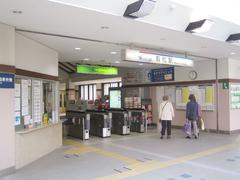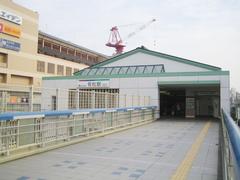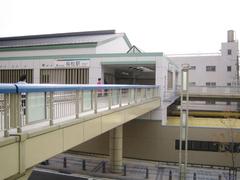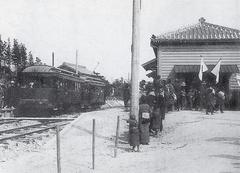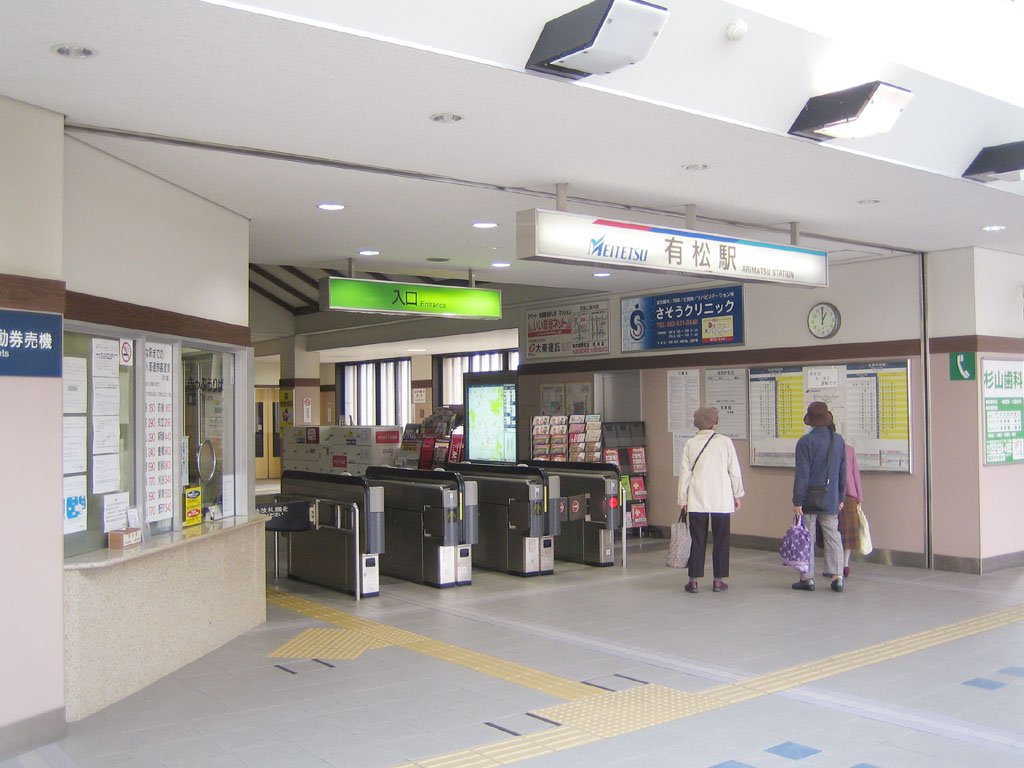
Arimatsu Station: Visiting Hours, Tickets, and Nearby Attractions in Nagoya, Japan
Date: 15/06/2025
Introduction
Arimatsu Station is more than just a transit point—it’s the doorway to a living museum of Japanese culture and artistry. Located in southern Nagoya along the Meitetsu Nagoya Main Line, Arimatsu is renowned for its remarkably preserved Edo-period streetscape and its world-famous Arimatsu-Narumi Shibori tie-dye craft. Founded as a post town in 1608 along the historic Tokaido Road, Arimatsu flourished as a commercial and cultural hub, balancing the needs of travelers with the innovation of its local artisans.
Today, visitors can explore its historic merchant houses, fire-resistant architecture, and vibrant festivals. This guide offers comprehensive visitor information—including visiting hours, ticketing, accessibility, transportation, and nearby attractions—while highlighting Arimatsu’s historical legacy and its ongoing cultural relevance. Whether you’re drawn by the artistry of tie-dye, Edo-period architecture, or the energy of traditional festivals, Arimatsu promises an immersive and authentic Japanese experience (Meitetsu Railway; Nagoya Is Not Boring; Japan Travel).
Contents
- Introduction
- History and Development of Arimatsu Station
- The Art of Arimatsu Shibori
- Architectural Heritage and Preservation
- Visiting Hours, Tickets, and Accessibility
- Nearby Attractions and Festivals
- Practical Travel Information
- FAQs
- Summary and Key Facts
- Official Resources
History and Development of Arimatsu Station
Arimatsu’s roots trace back to 1608, when it was established as a post town on the Tokaido Road, a vital link between Edo (now Tokyo) and Kyoto. As an auxiliary stop, Arimatsu provided safety and rest for travelers along a once-dangerous stretch (travel-around-japan.com). The town’s strategic placement quickly made it a center for commerce and hospitality, serving merchants, samurai, and pilgrims.
Initially, Arimatsu’s small size and proximity to Narumi-juku presented economic challenges. Local residents developed Arimatsu Shibori, an intricate tie-dye technique, to supplement their income—a craft that soon became the town’s defining legacy (tourguides.nagoya).
The Art of Arimatsu Shibori
Arimatsu Shibori, dating from the early Edo period (1603–1868), is a sophisticated tie-dye process involving binding, stitching, folding, and compressing fabric before dyeing. This method creates elaborate and distinctive patterns, and Arimatsu’s artisans became renowned for their skill (japannews.yomiuri.co.jp). The craft attracted travelers, who would purchase hand towels and garments as souvenirs, further spreading the fame of Arimatsu Shibori.
The tradition was immortalized by Utagawa Hiroshige in his ukiyo-e series “The Fifty-three Stations of the Tokaido,” which depicted the bustling tie-dye shops of Arimatsu (centrip-japan.com). Over time, the techniques spread to neighboring Narumi, resulting in the formal recognition of Arimatsu-Narumi Shibori as a national traditional craft.
Architectural Heritage and Preservation
Arimatsu’s streetscape, stretching roughly 500 meters along the old Tokaido Road, is lined with well-preserved Edo-period merchant houses, storehouses, and workshops. After a major fire in 1784, the community rebuilt its homes with fire-resistant tiled roofs and plastered walls, many of which survive today (tourguides.nagoya). Noteworthy examples include the Hattori-tei, Takeda, and Kozuka residences, which showcase original features such as latticework and inner gardens (meitetsu.co.jp).
Remarkably, Arimatsu was spared the destruction of World War II air raids, allowing the district’s architectural legacy to remain intact. This preservation effort is recognized with official designations as a Tangible Cultural Heritage site and a municipal preservation district (travel-around-japan.com).
Visiting Hours, Tickets, and Accessibility
Arimatsu Station
- Hours: Open daily, with train services from around 5:00 AM to midnight.
- Tickets: Purchase at station machines, counters, or via the Meitetsu Railway.
Arimatsu-Narumi Shibori Museum
- Hours: 9:00 AM–5:00 PM (last entry 4:30 PM); closed Wednesdays and during New Year holidays.
- Admission: ~300–500 yen for adults; discounts for children and groups.
Oka Family Residence
- Hours: Weekends, 10:00 AM–4:00 PM.
- Admission: 300 yen for adults, 150 yen for children (Good Luck Trip).
Accessibility
- Station: Ramps, elevators, and bilingual signage available.
- Historic District: Mostly flat and walkable; some buildings have steps or narrow entrances.
- Guided Tours: English-language tours and workshops available; pre-booking recommended (Trip To Japan).
Nearby Attractions and Festivals
Must-See Attractions
- Arimatsu-Narumi Shibori Museum: Artisan demonstrations, workshops, and a museum shop.
- Historic Tokaido Road: Stroll the preserved 500–800 meter streetscape lined with Edo-era buildings.
- Oka, Hattori, and Takeda Residences: Merchant houses reflecting the wealth and style of shibori wholesalers.
- Yamada House: Tourist information and cultural exhibits.
Annual Festivals
- Arimatsu Shibori Festival (June): Artisan parades, hands-on workshops, and vibrant market stalls. Next: June 7–8, 2025 (likenagoya.com).
- Floats Festival (October): Procession of ornate floats and karakuri puppets (meitetsu.co.jp).
Local Dining and Shopping
- Nagoya Meshi: Enjoy specialties like miso oden and Nagoya Cochin chicken at local eateries.
- Shibori Textiles: Purchase scarves, kimono, and home goods from artisan shops.
- Souvenirs: Traditional sweets, ceramics, and crafts available throughout the town.
Practical Travel Information
Getting There
- By Train: Take the Meitetsu Nagoya Main Line from Meitetsu Nagoya Station (adjacent to JR Nagoya Station) to Arimatsu Station. Travel time is about 20–22 minutes (Nagoya Is Not Boring).
- From Centrair Airport: Transfer at Meitetsu Nagoya Station; total journey about 50–60 minutes.
- IC Cards: Manaca, Toica, Suica, and other major cards are accepted (Nagoya Is Not Boring).
- Parking: Limited; public transportation is recommended.
Inside Arimatsu
- Walking: All main attractions are within a 3–5 minute walk from the station.
- Accessibility: Most streets are pedestrian-friendly, but some historic interiors may not be barrier-free.
- Tourist Info: English brochures and maps available at Yamada House and major sites.
FAQs
Q: What are Arimatsu Station’s visiting hours?
A: The station operates daily from approximately 5:00 AM to midnight.
Q: How do I buy train tickets?
A: Use ticket machines or counters at Meitetsu Nagoya Station; IC cards are accepted.
Q: Are there entrance fees for attractions?
A: The historic district is free to explore. The Shibori Museum and some residences charge 300–500 yen.
Q: Are guided tours available in English?
A: Yes, including shibori workshops. Booking in advance is recommended.
Q: Is Arimatsu accessible for wheelchairs?
A: The area is mostly flat, but some historic buildings may have limited accessibility.
Summary and Key Facts
- Historic Townscape Length: 500–800 meters
- Travel Time from Nagoya: 20–22 minutes by Meitetsu train
- Festival Highlights: Shibori Festival (June), Floats Festival (October)
- Cultural Designations: National Traditional Craft (Arimatsu-Narumi Shibori), Tangible Cultural Heritage
- Ticket Prices: Shibori Museum 300–500 yen; Oka Residence 300 yen
- Access: Meitetsu Nagoya Main Line; IC cards accepted
For up-to-date details, visit Aichi Now, Nagoya Info, or Japan and More.
Official Resources and Further Reading
- Arimatsu Station and Nagoya Historical Sites: Visiting Hours, Tickets, and Cultural Heritage Guide, 2025, Travel Around Japan
- Tour Guides Nagoya, 2025, Nagoya City Tourism
- Japan News Yomiuri, 2025, Arimatsu Shibori Feature
- Centrip Japan, 2025, Arimatsu Shibori History
- Meitetsu Railway, 2025, Nagoya and Arimatsu Guide
- Nagoya Is Not Boring, 2025, Cultural Heritage of Arimatsu
- Japan Travel, 2025, Arimatsu Travel Story
- Nagoya Info, 2025, Event and Tourism Details
- Japan and More, 2025, Arimatsu Shibori Festival
- Aichi Now, 2025, Arimatsu Historic District
- Hyperlocal Nagoya, 2025, Arimatsu Street Photography
- Trip To Japan, 2025, Shibori Workshops and Tours
Ready to experience Arimatsu’s storied past and vibrant present? Plan your visit, consult official resources for the latest updates, and consider downloading the Audiala app for personalized tours and real-time event information.
